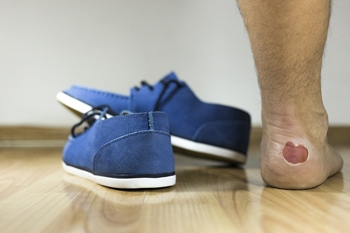The plantar fascia is a connective tissue in the heel that stretches across the bottom length of your foot. Plantar fasciitis occurs when the connective tissue becomes inflamed, causing heel pain and discomfort during physical activity. Although the condition is completely treatable, traditional methods can take up to a year to start becoming effective.
Plantar fasciitis is caused by a number of everyday activities, so understanding the condition is important for managing and treating it. One of the most common causes of plantar fasciitis is excessive running, especially with improper fitting or non-supportive shoes. Too much exercise can lead to the plantar fascia being overworked and overstretched, which can cause tears in the tissue. Along with improper fitting shoes, pronation, the rolling of the feet inward, is a common cause of plantar fasciitis. If not treated properly, the plantar fascia becomes overstretched and starts to tear, causing inflammation.
Despite the common causes of plantar fasciitis, there are many different treatment options. For less severe cases, conservative home remedies include taking anti-inflammatory drugs to alleviate pain, applying ice packs to the bottom of your foot and heel, slowly stretching and exercising your feet to re-strengthen the tissue, and using orthotic devices are all ways to help manage your plantar fasciitis.
For more severe cases, shockwave therapy has become a common solution for plantar fasciitis. Shockwave therapy can effectively break up the tissue on the bottom of your foot which facilitates healing and regeneration. This fights the chronic pain caused by plantar fasciitis. Even if this doesn’t work, surgery is always a final option. Surgery on the tissue itself can be done to permanently correct the issue and stop the inflammation and pain in your heels.
No matter what the case may be, consulting your podiatrist is the first and best step to recovery. Even the slightest amount of heel pain could be the first stage of plantar fasciitis. Untreated symptoms can lead to the tearing and overstretching of tissue. Because the tearing of tissue can be compounded if it remains ignored, it can evolve into a severe case. The solution is early detection and early treatment. Talk to your podiatrist about the possibilities of plantar fasciitis if you’re experiencing heel pain.


 There is a thick portion of tissue that runs along the bottom of the foot and connects the toes to the heel bone, which is referred to as the plantar fascia. If this should become injured, inflammation may occur, leading to a condition known as plantar fasciitis, which typically causes severe pain and discomfort. Research has shown the main purpose of the plantar fascia is to maintain adequate support to the arch of the foot in addition to acting like a shock absorber for the body. Some of the reasons why this ailment could develop may be from wearing shoes that do not have proper cushioning, standing for extended periods of time, or participating in sporting activities that include running or jumping. Patients who have plantar fasciitis may experience pain that radiates from the heel and may gradually increase over time. If you are afflicted with this painful condition, please counsel with a podiatrist who can properly diagnose and treat this condition.
There is a thick portion of tissue that runs along the bottom of the foot and connects the toes to the heel bone, which is referred to as the plantar fascia. If this should become injured, inflammation may occur, leading to a condition known as plantar fasciitis, which typically causes severe pain and discomfort. Research has shown the main purpose of the plantar fascia is to maintain adequate support to the arch of the foot in addition to acting like a shock absorber for the body. Some of the reasons why this ailment could develop may be from wearing shoes that do not have proper cushioning, standing for extended periods of time, or participating in sporting activities that include running or jumping. Patients who have plantar fasciitis may experience pain that radiates from the heel and may gradually increase over time. If you are afflicted with this painful condition, please counsel with a podiatrist who can properly diagnose and treat this condition.
Plantar fasciitis can be very painful and inconvenient. If you are experiencing heel pain or symptoms of plantar fasciitis, contact Dr.Eji Shobowale from DeNiel Foot & Ankle Center. Our doctor can provide the care you need to keep you pain-free and on your feet.
What Is Plantar Fasciitis?
Plantar fasciitis is the inflammation of the thick band of tissue that runs along the bottom of your foot, known as the plantar fascia, and causes mild to severe heel pain.
What Causes Plantar Fasciitis?
- Excessive running
- Non-supportive shoes
- Overpronation
- Repeated stretching and tearing of the plantar fascia
How Can It Be Treated?
- Conservative measures – anti-inflammatories, ice packs, stretching exercises, physical therapy, orthotic devices
- Shockwave therapy – sound waves are sent to the affected area to facilitate healing and are usually used for chronic cases of plantar fasciitis
- Surgery – usually only used as a last resort when all else fails. The plantar fascia can be surgically detached from the heel
While very treatable, plantar fasciitis is definitely not something that should be ignored. Especially in severe cases, speaking to your doctor right away is highly recommended to avoid complications and severe heel pain. Your podiatrist can work with you to provide the appropriate treatment options tailored to your condition.
If you have any questions please feel free to contact our office located in Cypress, TX. We offer the newest diagnostic and treatment technologies for all your foot and ankle needs.
Read more about Plantar Fasciitis


 If you’ve ever had a blister on your foot, you most likely may be aware of the discomfort that is often associated with it. It is known to occupy a small area on your foot, and is filled with a liquid that acts as a protective covering for the skin. The most common cause of foot blisters is friction, and this may be a result of wearing shoes and socks that are too tight. If the shoes that are worn, pinch the toes or heels, blisters may often form to protect the feet. There are additional ways for blisters to develop, and these may include having an allergic reaction, enduring frostbite or burns, or excessive moisture. If you have noticed blisters on your feet, it is advised to protect it by covering the blister with a bandage so the healing process can begin. If the blister should become infected, it’s suggested to speak with a podiatrist as quickly as possible to discuss the best treatments for you.
If you’ve ever had a blister on your foot, you most likely may be aware of the discomfort that is often associated with it. It is known to occupy a small area on your foot, and is filled with a liquid that acts as a protective covering for the skin. The most common cause of foot blisters is friction, and this may be a result of wearing shoes and socks that are too tight. If the shoes that are worn, pinch the toes or heels, blisters may often form to protect the feet. There are additional ways for blisters to develop, and these may include having an allergic reaction, enduring frostbite or burns, or excessive moisture. If you have noticed blisters on your feet, it is advised to protect it by covering the blister with a bandage so the healing process can begin. If the blister should become infected, it’s suggested to speak with a podiatrist as quickly as possible to discuss the best treatments for you.
Blisters may appear as a single bubble or in a cluster. They can cause a lot of pain and may be filled with pus, blood, or watery serum. If your feet are hurting, contact Dr.Eji Shobowale of DeNiel Foot & Ankle Center. Our doctor can provide the care you need to keep you pain-free and on your feet.
Foot Blisters
Foot blisters are often the result of friction. This happens due to the constant rubbing from shoes, which can lead to pain.
What Are Foot Blisters?
A foot blister is a small fluid-filled pocket that forms on the upper-most layer of the skin. Blisters are filled with clear fluid and can lead to blood drainage or pus if the area becomes infected.
Symptoms
(Blister symptoms may vary depending on what is causing them)
- Bubble of skin filled with fluid
- Redness
- Moderate to severe pain
- Itching
Prevention & Treatment
In order to prevent blisters, you should be sure to wear comfortable shoes with socks that cushion your feet and absorb sweat. Breaking a blister open may increase your chances of developing an infection. However, if your blister breaks, you should wash the area with soap and water immediately and then apply a bandage to the affected area. If your blisters cause severe pain it is important that you call your podiatrist right away.
If you have any questions, please feel free to contact our office located in Cypress, TX. We offer the newest diagnostic and treatment technologies for all your foot care needs.
Read more about Blisters


 There are several reasons why it may be necessary to have foot surgery performed. These may include having a foot deformity corrected, relieving severe pain and discomfort, or to have normal function returned to your foot or ankle. A common surgery that involves having the toenail removed may be a suitable cure for specific foot conditions such as ingrown toenails. Additionally, for people who suffer from the constant pain of an ankle disorder, a procedure that is known as open ankle fusion surgery may be a viable option to obtain moderate or full relief. Bunion surgery may be necessary for the permanent removal of painful bunions if all other options should fail. If you are contemplating foot surgery, it’s advised to speak with a podiatrist who can properly inform you of any information you need to know, so a proper decision can be reached.
There are several reasons why it may be necessary to have foot surgery performed. These may include having a foot deformity corrected, relieving severe pain and discomfort, or to have normal function returned to your foot or ankle. A common surgery that involves having the toenail removed may be a suitable cure for specific foot conditions such as ingrown toenails. Additionally, for people who suffer from the constant pain of an ankle disorder, a procedure that is known as open ankle fusion surgery may be a viable option to obtain moderate or full relief. Bunion surgery may be necessary for the permanent removal of painful bunions if all other options should fail. If you are contemplating foot surgery, it’s advised to speak with a podiatrist who can properly inform you of any information you need to know, so a proper decision can be reached.
Foot surgery is sometimes necessary to treat a foot ailment. To learn more, contact Dr.Eji Shobowale of DeNiel Foot & Ankle Center. Our doctor will assist you with all of your foot and ankle needs.
When Is Surgery Necessary?
Foot and ankle surgery is generally reserved for cases in which less invasive, conservative procedures have failed to alleviate the problem. Some of the cases in which surgery may be necessary include:
- Removing foot deformities like bunions and bone spurs
- Severe arthritis that has caused bone issues
- Cosmetic reconstruction
What Types of Surgery Are There?
The type of surgery you receive will depend on the nature of the problem you have. Some of the possible surgeries include:
- Bunionectomy for painful bunions
- Surgical fusion for realignment of bones
- Neuropathy decompression surgery to treat nerve damage
Benefits of Surgery
Although surgery is usually a last resort, it can provide more complete pain relief compared to non-surgical methods and may allow you to finally resume full activity.
Surgical techniques have also become increasingly sophisticated. Techniques like endoscopic surgery allow for smaller incisions and faster recovery times.
If you have any questions please feel free to contact our office located in Cypress, TX. We offer the newest diagnostic and treatment technologies for all your foot and ankle needs.
Read more about Foot Surgery


Your feet are covered a good part of the day. If you are diabetic, periodic screening is important for good health. Numbness is often another sign of diabetic foot and can mask a sore or wound.
Millions of people are affected by diabetes each year. Diabetes damages blood vessels in all parts of the body, especially the feet. The legs and feet may develop slow blood flow, which causes neuropathy, or nerve damage. Once a diabetic patient develops neuropathy, it is important that the feet are well taken care of. Otherwise, the lower limbs may have to be amputated. This only happens in drastic cases, but it shows how seriously diabetic foot care should be taken.
It is very important to always wash and dry the feet thoroughly, especially in between the toes, if you’re a diabetic. Secondly, examining your feet and toes for redness or sores must be done, even if you do not feel pain. You may also want to examine your feet from the bottom. Try to avoid wearing colored socks to prevent infections that may occur from the dye. Well-fitting socks are also highly recommended.
A diabetic’s physician should always monitor their blood levels to test how well blood sugars are being maintained. In addition to giving advice about everyday eating habits and foot care, a physician may prescribe medicine to help with the diabetic patient’s neuropathy. It is also advised to see a podiatrist if experiencing any feet conditions. Toenails may also need to be taken care of by a podiatrist. This prevents patients from cutting too deeply around their cuticles, which can lead to infection.
A person can take care of their feet at home by following the instructions of their physician. Using creams on one’s feet is also an effective way to heal dryness. Proceed with caution when using tools to remove calluses, as severe diabetics may not be able to feel pain on their feet. If any complications arise do not hesitate to contact a podiatrist.
On a daily basis, diabetic feet must be checked. If you are ever concerned about something, contact your health care professional. You never want to wait until a wound becomes too severe to treat. If left untreated, gangrene may develop. Gangrene is a serious infection that can lead to sepsis or amputation. It is also important for diabetics to be on the lookout for ulcers. Ulcers are sores that develop from tissue loss on the skin. They can be quite painful and require intensive treatment. Early treatment and everyday inspection are imperative to staying healthy.